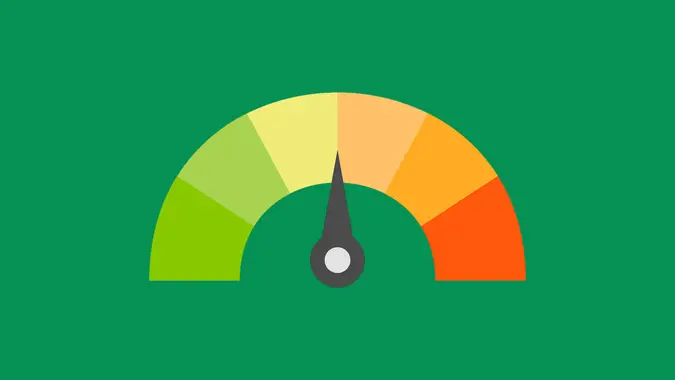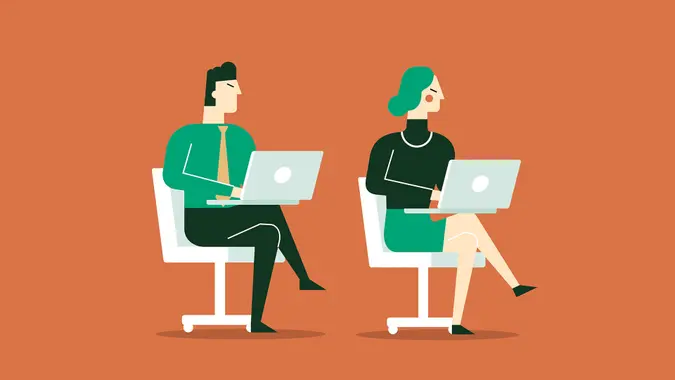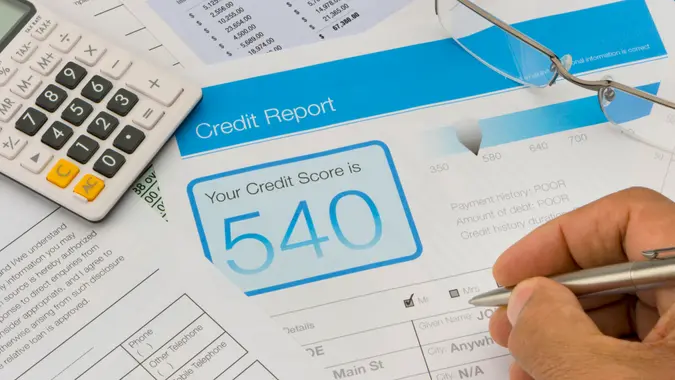What Is Credit Card Fraud Detection? Protecting Your Money

Commitment to Our Readers
GOBankingRates' editorial team is committed to bringing you unbiased reviews and information. We use data-driven methodologies to evaluate financial products and services - our reviews and ratings are not influenced by advertisers. You can read more about our editorial guidelines and our products and services review methodology.

20 Years
Helping You Live Richer

Reviewed
by Experts

Trusted by
Millions of Readers
Ever find your palms sweating as you enter your payment info into a merchant site you’ve never used before? It’s a natural response; few financial details are more important than your payment methods and keeping them secure. Not to mention that scammers have gotten quite good at stealing your credit card details.
Fortunately, banks do a great job of finding fraud. A rapscallion can use your card — but issuers make it a big hassle. Here’s what you need to know about credit card fraud detection.
What Is Credit Card Fraud Detection?
Credit fraud detection is the measure that credit card issuers take to keep your payment details safe. They do this in several different ways.
Banks use technology, AI, multi-factor authentication and much more to identify which purchases are yours and which are not. If they didn’t, you may go weeks or even longer without even noticing that someone else is using your credit line.
Even if you’ve just recently begun your journey in the world of credit, you’ve likely seen fraud detection in action. Ever received a text or email from your bank asking permission to approve a transaction at a gas station 900 miles away? That’s your bank preventing someone from spending your money.
How Does Credit Card Fraud Detection Work?
Credit card fraud detection works because your bank or card issuer has several methods to detect it quickly and easily. Your bank analyzes your transaction patterns and, if a purchase is made that is out of character for you, it’ll flag or even decline the transaction. You may receive a text, email or phone call from the issuer asking if you recently tried to make that purchase.
Because manually monitoring each transaction from every credit card user is impossible, banks use artificial intelligence to help them spot irregularities in your transactions. Of course, it’s not a perfect science; your card might be declined during a perfectly innocent purchase. This is because the bank found something about your spending to be abnormal.
How Does Credit Card Fraud Get Detected?
Real-Time Transaction Monitoring
As mentioned, monitoring every transaction for each customer is an overwhelming job for a card issuer. Banks use AI and machine learning to understand your spending patterns and discern when a purchase is “out of the ordinary.”
For example, if you make multiple purchases of the same amount over and over, or if you buy something on a foreign country’s website, the bank may flag the transaction and alert you. It may even allow the purchase — but it’ll send you a message to let you know it happened.
Banks obviously can’t predict the future. You’re bound to buy things that your bank didn’t foresee. Fortunately, you can push a transaction through immediately with just a tap or two on your phone. You’ll often get an email or text that asks if you’re trying to make a purchase. All you have to do is respond “yes” or “no.”
Geolocation and Device Tracking
This act may sound somewhat more invasive, but it’s one of the best preventative measures against fraud.
Banks track more than just the brands you shop with. They note the location where you tend to spend. All to say, the issuer knows the specific stores you’re swiping at — and even vacation spots you frequent. Some credit cards proactively note that you’ll be traveling if you use your card to buy airfare.
So if your card is used at a liquor store in a country you’ve never been to, expect the transaction to be flagged for fraud. You’ll likely receive text or email notifications, or both, and have your account frozen until you confirm the activity.
What Features Do Credit Cards Offer for Security?
Here’s how credit card companies use technology and behavior tracking to spot fraud before it costs you.
Multi-Factor Authentication and Biometric Features
If the bank senses that a charge may be fraudulent, it will reach out to ask for proof of your identity. You may be asked to enter a one-time password sent to your phone or email, or complete other multi-stage authentication steps.
The bank will often prompt you to update or strengthen your passwords if you’ve been compromised. Remember, scammers have evolved from simply trying to guess your password; in some cases, they’re using similar technology to what banks are using to keep you safe, like artificial intelligence.
If you use digital wallets like Apple Pay and Samsung Pay, your biometric data is your credit card’s primary security feature. At checkout, you’ll scan your fingerprint, iris, etc. to activate your phone’s payment feature.
EMV Chip Technology
EMV chips were a game changer when they were introduced a couple decades ago. They’re still a great security measure — and much more secure than the card’s magnetic stripe.
That’s because a magstripe holds your credit card information, while an EMV chip does not. With each purchase, the EMV chip creates a single-use token that is used to complete payment. If the data on your EMV chip is stolen, such as through a credit card skimmer, it’s largely useless. You can’t use its information to make another purchase.
They’re not impervious, since fraudsters have figured out a way to steal your card info anyway, but they make it much more difficult to hack.
Virtual Credit Card Numbers
Virtual credit card numbers serve a similar purpose to EMV chips in that they use “fake” payment credentials to complete a purchase. In other words, the payment processor never actually sees your credit card number. Payment platforms like Google Pay allow you to create multiple virtual credit cards for just about any credit card.
Virtual credit card numbers come in extra handy for online purchases, as EMV chips can’t protect online payments; you would need to enter your credit card details at the checkout page. Entering a virtual credit card number instead is a safer idea. You can even make them expire after a single use as an extra precaution.
Contactless Payment Security
Another spin on concealing your true credit card number is near-field communication, or NFC, encryption.
NFC technology makes it possible to use your phone to pay at brick-and-mortar retailers. It only works when it’s mere millimeters away from the credit card terminal, so it’s tough for a scammer to steal your info. NFC payment is also tokenized, which effectively means your credit card info is disguised.
Fraud Protection Policies and Zero Liability Guarantees
Even if your credit card data is successfully stolen, credit card issuers implement zero Liability policies that keep you from losing money, as long as you use them quickly.
When you realize your credit card has been used without your consent, contact the bank immediately. Once the bank is convinced that you haven’t been overtly negligent with your card, you shouldn’t be held responsible for any fraudulent charges.
What Should You Do If You Spot Fraudulent Transactions?
If you find fraudulent transactions, act immediately by doing the following:
- Ensure that you aren’t the one who made the purchase. The merchant on your statement may be ambiguously named, or you may have simply forgotten. You’d be surprised how often that happens.
- Call the number on the back of your credit card. You want to freeze your account as quickly as possible to prevent the thief from making additional purchases.
- Dispute the charge. It’s a good idea to dispute the charge within your online account, especially if you feel your card’s issuer may be buttoning up the issue. You should have the option to dispute each transaction online with just a few clicks. You may be asked some basic questions to confirm your identity and verify any other details around the disputed transaction.
- Watch your account closely. The banks don’t bat 1.000 when it comes to fraud prevention. Check your credit cards regularly to monitor for unauthorized charges.
The bank will charge off the fraud and send you a new credit card, typically within a few days.
How Credit Card Fraud Happens
Credit card thieves use several tactics to steal your information, including:
- Phishing: Fake emails or texts that trick you into sharing your details.
- Skimming: Devices placed on card readers that copy your card info.
- Account takeovers: Hackers gain access to your account and lock you out.
- Data breaches: Large-scale hacks that expose customer data from retailers or banks.
How To Protect Against Credit Card Fraud
As you can see, there are plenty of powerful steps you can take to thwart con artists. Consider:
- Setting up fraud alerts and transaction notifications with your card issuer
- Monitoring your credit card statements regularly
- Using secure passwords and enabling multi-factor authentication
- Exercising caution when using public Wi-Fi for transactions–assume someone is spying on you at all times
- Using digital wallets for added security.
No amount of prevention can guarantee you’ll be safe. Fraud prevention is all about minimizing risk. Take the steps above to give yourself the best chances of keeping your info protected.
Credit Card Fraud Detection FAQ
Here are the answers to some of the most frequently asked questions about credit card fraud detection.- How do banks know when a transaction is fraudulent?
- Banks often don't know that a transaction was fraudulent, but they can make an educated guess based on your transaction history. They look at your normal spending habits, the usual location of your spending, and even use AI to help them determine when to flag a charge.
- What features make credit cards more secure?
- The most secure feature of a credit card is its EMV chip, which disguises your payment information when you insert it into a credit card terminal. It's sort of like a third party that your credit card pays which passes the money along to the merchant.
- What should I do if my credit card is used without my permission?
- If your credit card is used without your permission, contact your issuer immediately and explain the situation. Major issuers offer zero liability protection, meaning you won't be on the hook for fraudulent charges. They'll deactivate your current card and send you a new one.
- Are fraud protection services worth it?
- Fraud protection services can be worth it if you're interested in identity theft insurance and other ancillary perks. But credit card issuers tend to offer sufficient fraud prevention measures -- and zero liability protection -- to satisfy the vast majority of situations.
Our in-house research team and on-site financial experts work together to create content that’s accurate, impartial, and up to date. We fact-check every single statistic, quote and fact using trusted primary resources to make sure the information we provide is correct. You can learn more about GOBankingRates’ processes and standards in our editorial policy.
- Alliant Credit Union. "Credit card fraud detection techniques."
- Stripe. 2023. "Credit card fraud detection and prevention: Best practices and tactics for businesses."
- Capital One. "What’s credit card fraud detection and why is it important?"
- Fidelity. 2024. "10 credit card security tips."
- UC Santa Cruz. "PCI-DSS: Card Present - Security Elements."
- Science Direct. "A supervised machine learning algorithm for detecting and predicting fraud in credit card transactions."
 Written by
Written by  Edited by
Edited by 






















